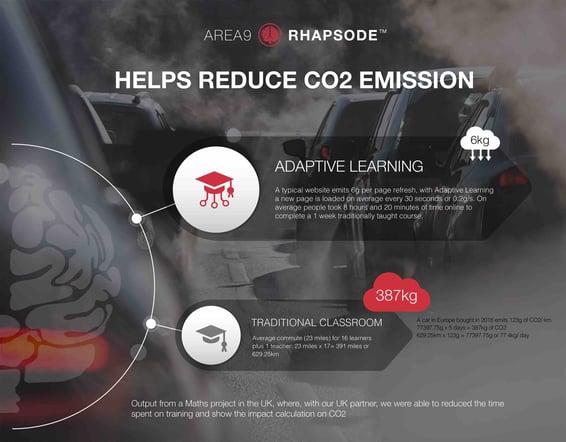Case Study Shows Surprising Results for Greener Footprint
Across the global economy, industry-wide solutions are needed, from “greener” electrical power grids to reducing emissions from agriculture. Education, too, has a crucial role to play, not only in providing knowledge, building skills, and encouraging innovation, but also as being part of the solution.
While there is a great need for upskilling and reskilling of employees at all levels, if we continue to roll out these learning activities only in the classroom, the cost in carbon emissions is staggering.
One of Area9’s partners, as part of a case study, has quantified the environmental benefits of computer-based adaptive learning compared with traditional classroom-based instruction. Changing the learning culture to online adaptive learning will not only build employees’ knowledge and competency, it will also contribute to reduced carbon dioxide (CO2) emissions. Here are their estimates and calculations for determining how the comparison stacks up:

As this comparison illustrates, a collateral benefit of engaging in adaptive learning can be to reduce CO2 emissions compared to a traditional classroom approach. Across many courses in many industries, the impact can be significant.
Learners, especially children and young adults, will always need to meet each other and their teachers and mentors to learn from social interactions and use their bodies and feelings to shape their character and sense of meaning and purpose. No adaptive learning technology can change that. But the more mature learners become, the more we can safely move most of their learning activities to adaptive, online environments without a loss in quality and even with an increase in the learning outcomes.
We need to rethink the upskilling and reskilling of employees along the lines of the challenge from climate change.
In this spirit of collaborative discussion and discovery, COP26, the United Nations’ Climate Change Conference hosted by the UK in partnership with Italy, has convened and will continue through November 12 in Glasgow, Scotland. Experts from every field and discipline—from agriculture to academics, transportation to technology—will come together not only to discuss, but also to commit to positive action on climate change.
As a final note, long-time friends of Area9, the arts collective Superflex, recently staged an art installation for the annual UN assembly. The installation celebrated a little-known sea species, the siphonophore, which works silently to complete the critical task of removing carbon from the atmosphere. Their work is beautifully shared in this New York Times article.
It serves as a reminder that the problem is too big for one industry, organization, or set of stakeholders, alone. It will take all of us, working together, to save our planet and secure the future.








